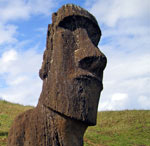Easter Island Moai Statues

Moai Carving (Fg. 3-1)
Discovered in the South Pacific Ocean on the Easter Sunday of 1722, Easter Island is widely known today for the very large free-standing megalithic Moai watching over the island. Nearly 900 unique Moai statues have been carbon dated estimating their creation between 1100 and 1680 with an estimation of a year or more of work per statue. Each Moai is said to resemble the deceased head of an ancestor. Many of massive 80 ton statues were chiseled from volcanic ash, remnant from the extinct volcanoes that originally formed the island. Methods of moving and lifting the Moai into place have remained an unexplained, controversial mystery. Easter Island heads are astronomically aligned precisely with seven, eighteen ton statues pointing directly to the sun setting during the equinox, named for the Seven Sisters or Pleiades. If the shoreline was once much further away, it's possible the statue alignment was planned out in an area with enough rock to carve and lift all Moai in the formation.
Methods of moving and lifting the Moai into place have remained an unexplained and somewhat controversial mystery. Researchers have attempted to recreate the Moai movement with such methods as rolling logs, walking the statues with long ropes, and wooden sleds to drag them into position. Moving the large monoliths is plausible by various methods, but researchers have not settled on the most likely approach together. Plus, there are other factors that make it difficult to accept those solutions, such as lack of enough timber on the island and the type of rope available for use in an isolated environment. There is one potential explanation which has yet to be explored. Carving sites where the Polynesians shaped rock into Easter Island heads are dug out in a specific way to allow the statues to be lifted upright by leverage. What if the Moai were simply carved in place and lifted upward at the same location and then packed around the base with the dugout soil?
Polynesians who inhabited Rapa Nui estimated to be between 300 and 800CE chose a representative of Make-make, the great creator, titled the Bird Man each year to live in seclusion. Effigies of the Bird Man resemble a human with a bird head and wings distinctly similar to depictions found in the ancient Egyptian culture. The Bird Man is also a deity figure found in some ancient American Indian lore with a very similar description, having a head and wings like an eagle with the body of a man. A very similar motif may be found throughout reliefs in Egypt, and is commonly found in the historical record of several different cultures from around the world.
† Article 3-1
